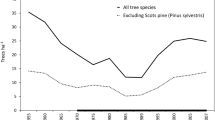Abstract
COST (COST is an intergovernmental framework for European cooperation in science and technology. COST funds network activities, workshops and conferences with the aim to reducing the fragmentation in European research) Action E47, European Network for Forest Vegetation Management—Towards Environmental Sustainability was formed in 2005 and gathered scientists and practitioners from eighteen European countries with the objective of sharing current scientific advances and best practice in the field of forest vegetation management to identify common knowledge gaps and European research potentials. This paper summarizes the work of the COST action and concludes that although diverse countries have by necessity adopted different means of addressing the challenges of forest vegetation management in Europe in the 21st century, some common themes are still evident. In all countries, there is a consensus that vegetation management is a critical silvicultural operation to achieve forest establishment, regeneration, growth and production. It appears that herbicides are still in use to some degree in all the countries reviewed, although at a lower intensity in many of the northern countries compared to other regions. The most common alternatives to herbicides adopted are the use of mechanical methods to cut vegetation and achieve soil cultivation; overstorey canopy manipulation to control vegetation by light availability; and in some instances the use of mulches or biological control. Any reductions in herbicide use achieved do not seem to have been driven solely by participation in forest certification schemes. Other factors, such as national initiatives or the availability of additional resources to implement more expensive non-chemical approaches, may be equally important. The development of more cost-effective and practical guidance for managers across Europe on non-chemical control methods can best be brought about by future collaborative research into more sustainable and holistic methods of managing forest vegetation, through the identification of silvicultural approaches to reduce or eliminate pesticide use and through gaining a better understanding of the fundamental mechanisms and impacts of competition.





Similar content being viewed by others
Notes
a.i. active ingredient.
References
Balandier P, Collet C, Miller JH, Reynolds PE, Zedacker SM (2006) Designing forest vegetation management strategies based on the mechanisms and dynamics of crop tree competition by neighbouring vegetation. Forestry 79(1):3–27
Balandier P, Frochot H, Sourisseau A (2009a) Improvement of direct tree seeding with cover crops in afforestation: microclimate and resource availability induced by vegetation composition. For Ecol Manage 257:1716–1724
Balandier P, Frochot H, Sourisseau A (2009b) Foundations of the cover crop technique and potential use in afforestation. In: Bentsen NS (ed) Forest vegetation management—towards environmental sustainability. Proceedings from the final COST E47 Conference, Vejle, Denmark, 2009/05/5–7, Forest and landscape working papers no 35-2009, pp 60–61
Bentsen NS (ed) (2009) Forest vegetation management—towards environmental sustainability. In: Proceedings from the final COST E47 Conference, Vejle, Denmark, 2009/05/5–7, Forest and landscape working papers no 35-2009, pp 60–61
Callaway RM, Walker LR (1997) Competition and facilitation: a synthetic approach to interactions in plant communities. Ecology 78(7):1958–1965
Danish Forest and Nature Agency (2009) www.skovognatur.dk. Accessed June 2009
Dodet M, Collet M, Frochot H, Wehrlen L (2010) Tree regeneration and plant species diversity responses to vegetation control following I major windthrow in mixed broadleaved stands. Eur J Forest Res. doi:10.1007/s10342-010-0406-z
FAO (2009) FAOSTAT resource statistics, www.faostat.fao.org. Accessed June 2009
Forest Stewardship Council (2007) FSC guidance document: FSC-GUI-30-001 Version 2-0 EN. Forest Stewardship Council: www.fsc.org
Forest Stewardship Council (2009) www.fsc.org. Accessed June 2009
Fortier J, Messier C, Coll L (2005) La problématique de l’utilisation des herbicides en foresterie: le cas du Québec. Vertigo 6:2
Frochot H, Collet C, Balandier P, Wagner R (2003) Technical, environmental and economic challenges of forest vegetation management—4th International conference on forest vegetation management—IFVMC4—17–21 June 2002, Nancy, France—Foreword. Ann For Sci 60(7):558
Gama A, Dumas Y, Frochot H (2006) Utilisation des herbicides en forêt et gestion durable. Editeur Quae, France
Gaudio N, Balandier P, Marquier A (2008) Light-dependent development of two competitive species (Rubus idaeus, Cytisus scoparius) colonizing gaps in temperate forest. Ann For Sci 65(104):5
Gaudio N, Balandier P, Philippe G, Dumas Y, Jean F, Ginisty C (2010) Light-mediated influence of three understorey species (Calluna vulgaris, Pteridium aquilinum, Molina caerulea) on growth and morphorlogy of Pinus sylvestris seedlings. Eur J Forest Res. doi:10.1007/s10342-010-0403-2
Gómez-Aparicio L, Gómez JM, Zamora R, Boettinger JL (2005) Canopy vs. soil effects of shrubs facilitating tree seedlings in Mediterranean montane ecosystems. J Veg Sci 16:191–198
Green S (2003) A review of the potential for the use of bioherbicides to control forest weeds in the UK. Forestry 7:285–298
Hamberg L, Malmivaara-Lämsä M, Löfström I, Vartiamäki H, Valkonen S, Hantula J (2010) Sprouting of Populus tremula L. in spruce regeneration areas following alternative treatments. Eur J Forest Res. doi:10.1007/s10342-010-0372-5
Harper GJ, Comeau PG, Hintz W, Wall RE, Prasad R, Becker EM (1999) Chondrostereum purpureum as a biological control agent in forest vegetation management. II. Efficacy on Sitka alder and aspen in western Canada. Can J For Res 29:852–858
Huffel G (1926) Les méthodes de l’aménagement forestier en France. Berger-Levrault, Paris
Hytönen J, Jylhä P (2008) Fifteen-year response of weed control intensity and seedling type on Norway spruce survival and growth on arable land. Silva Fennica 42(3):355–368
Kristoffersen P, Larsen S U, Møller J, Hels T (2004) Factors affecting the phase-out of pesticide use in public areas in Denmark. Pest Manage Sci 60(8):605–612
Little KM, Willoughby I, Wagner RG, Adams P, Frochot H, Gava J, Gous S, Lautenschlager RA, Örlander G, Sankaran KV, Wei RP (2006) Towards reduced herbicide use in forest vegetation management. South Afr For J 207(17):63–79
Living Forest (2009) The living forest standard. www.levendeskog.no. Accessed June 2009
McCarthy N, McCarthy C (2005) Herbicides and forest vegetation management: a review of possible alternatives. Irish For 62 (1 and 2):44–55
National Forestry Database (2010) Pest control product use—National tables. Accessed July 2010. http://nfdp.ccfm.org/pest/national_e.php
Newton M, Balandier P (2004) Social and Economic considerations in forest vegetation management: a synthesis from the Fourth International Conference on Forest Vegetation Management, 3 May 2004, 6 p. http://www.ifvmc.org/ifvmc4-social.html
Pages J-P, Michalet R (2003) A test of the indirect facilitation model in a temperate hardwood forest of the northern French Alps. J Ecol 91:932–940
Papachristou TC, Platis PD (2009) Grazing of livestock as control of herbaceous vegetation in coppice oak forests in Greece: trade-offs between herbs and oak sprouts in foraging decisions. In: Bentsen NS (ed) Forest vegetation management—towards environmental sustainability, Proceedings from the final COST E47 Conference, Vejle, Denmark, 2009/05/5–7, forest and landscape working Papers no 35-2009, pp 18–20
Peel MC, Finlayson BL, McMahon TA (2007) Updated world map of the Köppen-Geiger climate classification. Hydrol Earth Syst Sci Discuss 4(2):439–473
Prévosto B, Balandier P (2007) Influence of nurse birch and Scots pine seedlings on early aerial development of European beech seedlings in an open-field plantation of central France. Forestry 80(3):253–264
Prévosto B, Monnier Y, Ripert C, Fernandez C (2010) Diversification of Pinus halepensis forests by sowing Quercus ilex and Quercus pubescens acorns: testing the effects of different vegetation and soil treatments. Eur J Forest Res. doi:10.1007/s10342-010-0396-x
Programme for the Endorsement of Forest Certification schemes (2009) http://register.pefc.cz/statistics.asp. Accessed June 2009
Rackham O (1990) Trees and woodlands in the British landscape. J. M. Dent and Sons Ltd, London
Schütz JP (2004) Opportunistic methods of controlling vegetation, inspired by natural plant succession dynamics with spatial reference to natural outmixing tendencies in a gap regeneration. Ann For Sci 61:149–156
Seier MK (2009) Biological control of invasive weeds—a tool for integrated vegetation management. In: Bentsen NS (ed) Forest vegetation management—towards environmental sustainability, Proceedings from the final COST E47 Conference, Vejle, Denmark, 2009/05/5–7, Forest and Landscape Working Papers no 35-2009, pp 36–38
Shepard JP, Creighton J, Duzan H (2004) Forestry herbicides in the United States: an overview. Wildl Soc Bull 32(4):1020–1027
Smit C, den Ouden J, Diaz M (2008) Facilitation of Quercus ilex recruitement by shrubs in Mediterranean open woodlands. J Veg Sci 19:193–200
Thiffault N, Roy V (2010) Living without herbicides in Québec (Canada): historical context, current strategy, research and challenges in forest vegetation management. Eur J Forest Res. doi:10.1007/s10342-010-0373-4
Thompson DG, Pitt DG (2003) A review of Canadian forest vegetation management research and practice. Ann For Sci 60:559–572
Van Lerberghe P (2004) Mulching in ligneous plantations as an alternative to chemical weeding. Forêt-entreprise 157:4–8
Vartiamäki H, Maijala P, Uotila A, Hantula J (2008) Characterization of growth and enzyme production of Chondrostereum purpureum isolates and correlation of these characteristics with their capability to prevent sprouting of birch in field. Biol Control 47:46–54
Wagner RG, Flynn J, Gregory R (1998) Public perceptions of risk and acceptability of forest vegetation management alternatives in Ontario. For Chron 77(5):720–727
Wagner RG, Keith ML, Richardson B, McNabb K (2006) The role of vegetation management for enhancing productivity of the World’s forests. Forestry 79:57–79
Wagner S, Fischer H, Huth F (2010) Canopy effects on vegetation caused by harvesting and regeneration treatments. Eur J Forest Res. doi:10.1007/s10342-010-0378-z
Willoughby I (1999) Future alternatives to the use of herbicides in British forestry. Can J For Res 29:866–874
Willoughby I, McDonald HG (1999) Vegetation management in farm forestry: a comparison of alternative methods of inter-row management. Forestry 72(2):109–121
Willoughby I, Evans H, Gibbs J, Pepper H, Gregory S, Dewar J, Nisbet T, Pratt J, McKay H, Siddons R, Mayle B, Heritage S, Ferris R, Trout R (2004) Reducing pesticide use in forestry. Forestry Commission Practice Guide, Forestry Commission, Edinburgh
Willoughby I, Balandier P, Bentsen NS, Mc Carthy N, Claridge J (eds) (2009) Forest vegetation management in Europe. COST Office, Brussels, p 156
Acknowledgments
The authors wish to thank all members of COST Action E47 for their contribution to the review on applied forest vegetation management methods. We also thank COST for economic support to the network activities carried out in COST Action E47. The anonymous reviewers have provided valuable comments and suggestions for improving the manuscript.
Author information
Authors and Affiliations
Corresponding author
Additional information
Communicated by C. Ammer.
This article originates from the final conference of the Cost action E47 ‘‘European Network for Forest Vegetation Management: Towards Environmental Sustainability’’ in Vejle, Denmark, 4–7 May 2009.
Rights and permissions
About this article
Cite this article
McCarthy, N., Bentsen, N.S., Willoughby, I. et al. The state of forest vegetation management in Europe in the 21st century. Eur J Forest Res 130, 7–16 (2011). https://doi.org/10.1007/s10342-010-0429-5
Received:
Revised:
Accepted:
Published:
Issue Date:
DOI: https://doi.org/10.1007/s10342-010-0429-5




